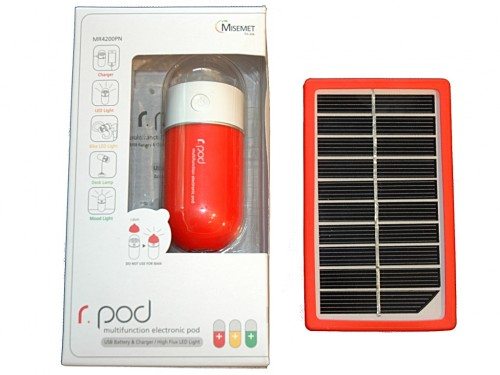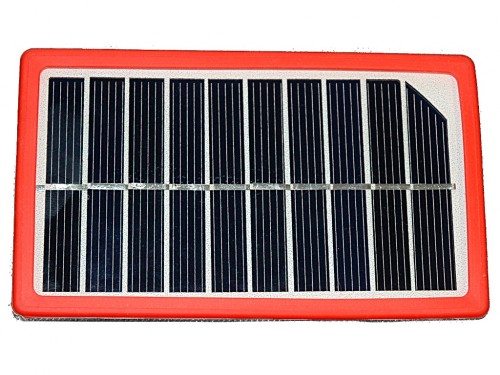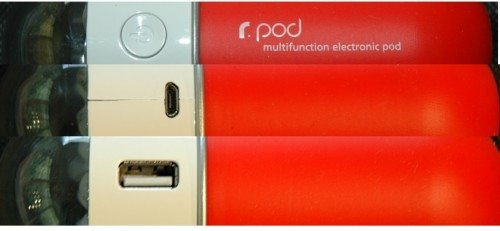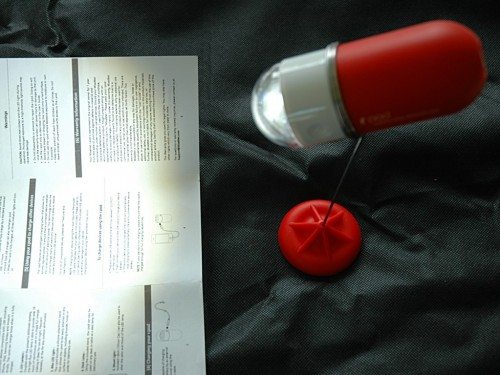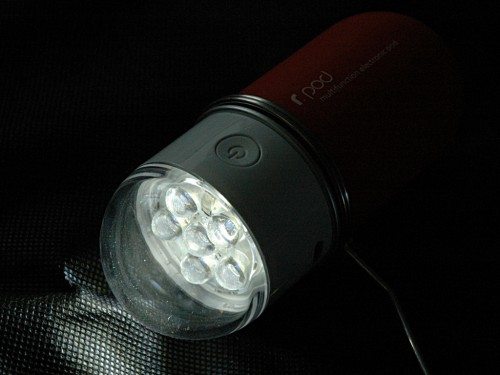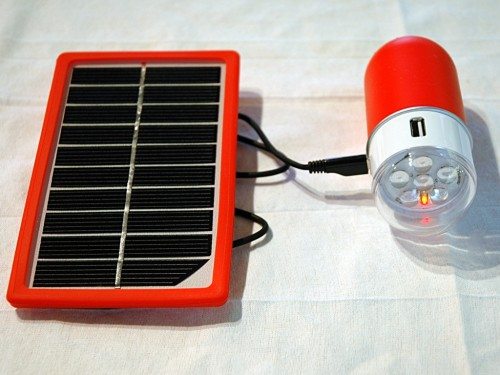The Misemet r.pod multifunction electronic pod and solar charger is not only a mouthful to say, it’s also a multifunction workhorse for off-the-grid power and light. Available in red, yellow, or green colors, it consists of the r.pod itself, which looks for all the world like a gigantic cold capsule, a handful of accessories, and a large solar panel. This collection of goodies hopes to provide you will off-grid USB power, light, mood lighting, and in a pinch, an SOS distress beacon.
Unbox All The Things
The r.pod box contains the r.pod itself, a metal stand and base, a transparent cap (in the same color you choose for the r.pod) for “mood lighting”, A micro-USB cable for charging it r.pod itself, a multi-purpose strap, and the user manual. The solar panel is packaged separately, although it does not appear you can purchase the r.pod without it.
Buttons and Ports
Mobile power is always a trade-off between size and capacity. How much power can you store, and how large/heavy is that power going to be? The r.pod clearly isn’t meant to be put in your pocket. It’s backpack sized – ideal for a hike, a camping trip, or (if the Mayans were right) riding out the apocalypse. The Solar panel is roughly 2.5 ” X 4″ in cross-section and 0.5″ tapering down to 1/3″ thick. It weighs about the same as the r.pod, about a third of a pound. The housing is a soft silicone; the color matches the r.pod.
The front is all solar panel, the back has a standard USB port to connect it to the r.pod:
Its output is rated at 5V, 330mA, 1.65 watts. There is no way to clip the panel to anything – nor is there an included stand/angle brace – you’ll need to be stationary to charge the r.pod with it and prop it up to best catch the sun/available light. The panel is able to generate electricity from ambient light, but obviously full, direct sun generates the most power.
The r.pod itself houses the Li- polymer 3.7V, 4000mA / 14.8 WH battery. It’s not small at 4.7″ long and 2″ in diameter, nor is it light at about 1/3 pound. It has one button and two ports on its sides.
The full sized USB port delivers power to whatever you’re charging, and the micro-USB port is used to recharge the r.pod. The button is multi-function. Press it once to turn on/off the 5 bright white LED lamps. When the LEDs are on, press and hold it to turn on the SOS flash pattern. When the LEDs are off, press and hold it to see the current battery level on the front of the r.pod:
The battery strength/charge/discharge indicator is on the front. It’s a set of red/yellow/green LEDs that show the battery level. When charging or discharging, the three will light in series to let you know power is flowing in or out.
The back of the r.pod has a “multi-ring” attachment point – probably too narrow for a large carabiner, but you could easily get some kind of strap through it to hang the r.pod up in your tent.
The r.pod comes with a cute base and wire system that you can use to set it up as a reading lamp. However there is no pouch provided to carry this or the mood light cap with you, meaning you’re just as likely to leave these behind on a camping trip.
The five LEDs are rated at 50,000 hours lifespan, and provide a fairly focused and very bright light. You can use the r.pod as a bike light, using the provided strap to hook it onto your handlebars.
Other than looking somewhat odd, the rubber cap provides a mood light experience should you wish to tone down the light a bit.
More Power!
The capacity of the r.pod (when full) is impressive. On the discharge side of the power equation, you’ll be able to use the light for 18 hours on a single charge. If you’re charging up devices you should be able to get two full recharges of most smart phones or similar sized devices off the r.pod, and roughly one full iPad/tablet recharge. The power output from the USB port is rated at 5V, 500mA (2.5W).
Unfortunately, recharging the r.pod itself via the sun or USB isn’t that fast:
The panel in good sun will need 12 hours to fully charge it. (EE majors, please excuse this simplification.) This makes sense given the panel puts out 330ma, and the r.pod’s battery is 4000mah (4000mAh/330ma = 12.12h.) By this same simplified math, you can guess that charging via a 500ma USB source would take about 8 hours, and via a high-powered USB source at 1amp, about 4 hours.
In practice, I achieved these three recharge times fairly closely using the panel, an old 500ma USB/AC adapter, and a 1 amp AC adapter to recharge the r.pod. Clearly the more power you can push into it, the faster it will charge. In a camping setting where you’ve set up a base camp, you could leave the r.pod and panel in the sun all day and store up enough power for one recharge and 6 hours or so of light that night. If you’re backpacking all day, you’d have to find some way to rig the solar panel onto your backpack so it’s more or less in the sun, a tricky proposition given the total absence of attachment points on the panel.
Mad Max gives it Two Thumbs Up
Overall I found the r.pod to be a capable and high-capacity mobile power source with a couple of added functions (light/sos signal/funky mood light cap) tossed in that give it even more utility as a camping/off grid accessory. The solar panel size vs capacity trade off isn’t great – 12 hours sitting in the sun every day to recharge would be tricky unless you’re camping in the Outback or Death Valley, but a solar array large enough to generate sufficient power for a fast charge would be way more cumbersome to carry. It would have been nice to have a strap/hook on the top of the panel to allow it to be securely hung off a backpack; as it is, you’re pretty much limited to stationary solar charging. But hey, if you’re using your iPad while you’re camping, you’re probably stationary anyway!
Gerber Gear 22-47162N Fast Draw Folding Assisted Opening Pocket Knife, Fine Edge, Black
$42.66 (as of 12/29/2025 17:04 GMT -06:00 - More infoProduct prices and availability are accurate as of the date/time indicated and are subject to change. Any price and availability information displayed on [relevant Amazon Site(s), as applicable] at the time of purchase will apply to the purchase of this product.)Gerber Gear EVO Jr. Folding Knife - Serrated Edge [22-41493]
$28.99 (as of 12/29/2025 17:02 GMT -06:00 - More infoProduct prices and availability are accurate as of the date/time indicated and are subject to change. Any price and availability information displayed on [relevant Amazon Site(s), as applicable] at the time of purchase will apply to the purchase of this product.)Product Information
| Price: | $79.99 (discounted online at most web resellers) |
| Manufacturer: | Misemet |
| Requirements: |
|
| Pros: |
|
| Cons: |
|

